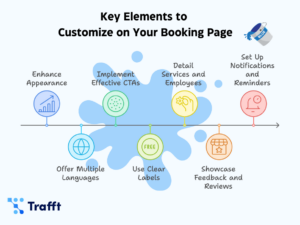Efficient employee scheduling is a critical aspect of managing a business with multiple locations. When you have only one location, it can get messy, but when you have multiple locations, you have to think ahead and overcome the problems before they arise. That’s why employee scheduling for multiple locations is a skill for itself.
Everyone thinks “It’s easy for you, you have a large business”, but they don’t realize how hard even the most basic things are and how much the mistakes can cost you. Because of that, we’re going to discuss one of the most common problems owners and managers face when it comes to multi-location employee scheduling, but also how to overcome them and master this skill to improve productivity and ensure seamless operations – at every location.
The Importance of Efficient Multi-Location Employee Scheduling
In a world where small, one-location businesses are often shut down by big organizations, it’s a great idea to expand your reach and open up more locations to operate in. You’ll diversify your income stream, reach new heights and expand your business in new markets. While it’s an excellent opportunity, there are some issues that arise when you have more than one business location.
Multi-location employee scheduling is an essential element of the successful expansion of your business. It ensures that each location has enough staff and that it’s contributing to exceptional customer experience, and offers consistent customer service. Efficient multi-location employee scheduling is important because it ensures that every employee is assigned the right shifts and right locations.
When you master employee scheduling for multiple locations, it fosters a sense of balance and equality among employees, which influences the quality of services they provide. Better yet, you’ll cut costs and eliminate overstaffing or understaffing issues, which will make all your business operations smooth, cost-efficient, and productive.
Common Problems with Employee Scheduling for Multiple Locations
If you can’t quite get a grasp of employee scheduling for multiple locations, then you’ve already encountered these problems. However, it’s one thing to be aware of them, and completely another to tackle them. By understanding common problems with multi-location employee scheduling and why they occur, we’ll make a first step toward resolving them.
Let’s see what happens if you don’t effectively do employee scheduling for multiple locations:
Scheduling conflicts
When we talk about scheduling conflicts, we don’t just mean things like double bookings and preventing them. You should also think about how to strike the perfect balance between employee availability and their preferences. Organizing schedules when you operate in multiple locations is like orchestrating a complex symphony. Your job as an owner or manager is to harmonize each employee’s availability, preferences, and responsibilities seamlessly. This is easier said than done, obviously.
Scheduling conflicts often arise when employees have overlapping shifts or when their preferences clash with the operational needs of different locations. These scheduling problems not only lead to frustration among employees but also compromise productivity and customer experience. Because of that, you should find the right balance between preferences and business demands when doing employee scheduling for multiple locations.
Communication among managers
Effective communication is the cornerstone of successful multi-location employee scheduling. In an environment where managers and staff are spread across various sites, miscommunication equals chaos. Imagine a scenario where a last-minute shift change goes unnoticed by an employee due to poor communication. It can result in an unexpected staff shortage, leading to subpar services your customers definitely don’t deserve.
In order to overcome this problem with multi-location employee scheduling, you have to implement clear communication channels and protocols. Regular updates, alerts for schedule changes, employee reminders, and open lines of communication between management and staff are essential to prevent misunderstandings and keep operations running smoothly.
Complexity
Juggling diverse roles, skill sets, and labor laws is definitely challenging and time-consuming. It adds a layer of complexity when you’re trying to do employee scheduling for multiple locations. As a manager, you might coordinate full-time employees, and part-time staff and each of them has unique qualifications, availability, and preferences.
Its unlimited variables require a comprehensive appointment system in place in order to create bulletproof multi-location employee scheduling.
Last-minute changes
When figuring out how to navigate staff scheduling for multiple locations effectively, you also have to take into consideration unpredictable events. They can throw a wrench even if you do everything right and mess up your meticulously crafted employee schedules.
The most important thing for managers to do here is to react promptly. Only then can you expect to minimize the impact last-minute changes have on business operations. More often than not, you’ll have to make adjustments on the fly and ensure the right employees are there to maintain quality service and meet business demands.
Lack of insights
Sometimes, it may seem like you’re navigating the maze blindfolded. Multiple locations mean you need to be at more than one place at the same time, which is of course, impossible. However, you need to have a comprehensive overview of employee schedules, availability, and workload at all times in order to make informed decisions.
If you don’t – you spend too much money, and risk overstaffing, understaffing, and misallocating resources. In the long run, this can seriously harm your business, your revenue, and your productivity.
Problems with tracking
Managing time and attendance across multiple locations often involves juggling disparate systems, spreadsheets, or even manual paper-based processes. This approach leads to errors, inconsistencies, and other difficulties. Once you have a unified and centralized employee scheduling system for multiple locations, you’ll get a comprehensive understanding and see data insights for everything. It’s the key to accurately keeping records and simplifying reporting and scheduling for everyone.
And now onto resolving these problems!
Guide to Mastering Employee Scheduling for Multiple Locations
Efficient multi-location employee scheduling doesn’t have to be a daunting task even though it requires a strategic and systematic approach. Look on the brighter side, because once you have a system in place, everything will be easier down the road. Ensuring optimal staffing levels, exceptional customer service, and promoting employee satisfaction are key goals. To achieve them, we’ve prepared a comprehensive guide to help you master multi-location employee scheduling:
1. Implement a centralized booking system
If you don’t have one place that’s the center of your booking universe, there are going to be a lot of problems sooner or later. A centralized booking system allows managers and staff from various locations to communicate without bottlenecks in the process. It facilitates real-time updates and sends reminders as soon as a change happens, while managers and employees can review and change their availability on the go. And all that from one centralized platform that keeps everyone in the loop.
2. Take advantage of data analysis and forecasting
Historical data about bookings is a gold mine for owners and managers who want to efficiently do employee scheduling for multiple locations. By analyzing it, you can easily predict staffing needs for each location and analyze patterns such as peak hours, seasonal variations, and no-show rates. With a vast array of workforce analytics software available there are numerous tools that can gather, examine, and display employee data to assist companies in making informed decisions about their staff. This will guide you to make informed decisions and avoid miscommunication issues.
3. Cross-train employees
When you cross-train employees to broaden their skill sets, you add an extra layer of flexibility to your multi-location scheduling. Once most of your employees have versatile skills with a help of an effective training program that allows them to work across different locations, you’ll easily fill unexpected gaps in scheduling. More importantly, you’ll equip your team with the power to seamlessly tackle unexpected issues.
4. Make room for flexibility
If you want to boost employee satisfaction and still do multi-location employee scheduling like a pro, it’s important to make room for flexibility. Allow employees to self-manage their appointments and sync all of their calendars with work schedules. They’ll stay on top of things even when last-minute changes occur. Additionally, flexible scheduling options allow employees to choose locations and shifts based on their preferences making it easier for everyone to coordinate their work responsibilities.
5. Establish communication channels and protocols
When you constantly have open lines of communication, multi-location scheduling isn’t as hard as it seems. Create a company culture that fosters regular check-ins and updates among staff at different locations. To achieve transparent communication and promptly address scheduling changes, you have to develop communication protocols and stick to them. Choose channels of communication that work well with your booking system such as automated reminders and forget about misunderstandings.
6. Empower employees with self-service tools
Providing your employees with a user-friendly platform will reduce the manual administrative work while allowing them to manage their availability. Employees will have their autonomy, while managers have more time to devote to essential business tasks. If you allow staff to swap schedules with one another, you’ll avoid lengthy processes that are frankly, unnecessary.
7. Don’t forget about work-life balance!
When doing employee scheduling for multiple locations, it’s important to have work-life balance in mind. You don’t want employees who live 2 hours away from one location to work there, especially when you can leverage technology like VPN to connect to the centralized network of your physical office. Whether you will be looking to buy a static proxy, rotating, private or shared one, consider reading more in depth articles that discern the different types of proxies, as they sometimes serve completely disparate needs. Create schedules that take into account their preferences and personal commitments to foster a healthy work-life balance. It’s important to respect every single employee and take into consideration their preferences. Even if you can’t always provide them with shifts and locations that work for them, it’s important to not make that a habit. It will lead to higher job satisfaction, productivity, and improved mental well-being among staff.
8. Embrace employee scheduling software for multiple locations
Employee scheduling software for multiple locations offers a range of benefits and tools to make it all possible. You can set up automation, such as reminders, invoicing, and payment processing to reduce manual labor and errors. Scheduling software for multiple locations also lets you set up rules and gives you enough data to analyze staffing needs for each location.
Take Advantage of Employee Scheduling Software for Multiple Locations
Employee scheduling software that supports multiple locations is a game changer for your business. You have advanced features at your fingertips that are designed to simplify and enhance the scheduling process. What will you get?
You’ll get a centralized platform where you can manage, create, adjust, and communicate employee schedules and appointments across different locations. You also get real-time updates about any changes, no-shows, last-minute cancellations and reduce scheduling conflicts. Scheduling is completely automated, as customers can choose their preferred location and employees who work there.
Besides these features, Trafft’s employee scheduling software for multiple locations also offers you an insightful business dashboard to analyze historical data and predict future staffing needs with unparalleled accuracy. Based on your preferences, you can set up custom managerial roles and allow your employees to self-service, manage availability, and schedules, and even swap shifts with colleagues.
Automated employee reminders make sure everyone is kept in the loop about changes, no matter how sudden or unexpected they are. Employees can get SMS, WhatsApp, or Email reminders and make changes to their schedule on the fly.
With powerful marketing and payment integrations, Trafft is here for you with one superior goal in mind – to make life better for you, your customers, and your staff. It seamlessly adapts to your business and acts as a business partner that takes care of repetitive tasks without errors.
Ready to master employee scheduling for multiple locations without a hassle?
Choose your favorite plan and sign up for Trafft for free.
FAQ about Multi-Location Employee Scheduling
How do you schedule multiple employees?
A step-by-step guide to scheduling multiple employees:
- Create employee profile
- Assign them services
- Assign them a location or multiple locations they operate in
- Let them choose their availability or set up availability yourself
How do I schedule multiple locations on Trafft?
You can add multiple locations in your Trafft multi-location scheduling software, including virtual ones. Once you’ve added all the locations you operate in, it’s time to assign employees and services to that location. Another thing you should do is set working hours for each location and availability time for each employee who works there.



